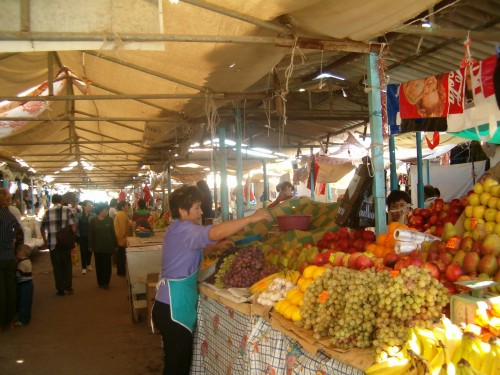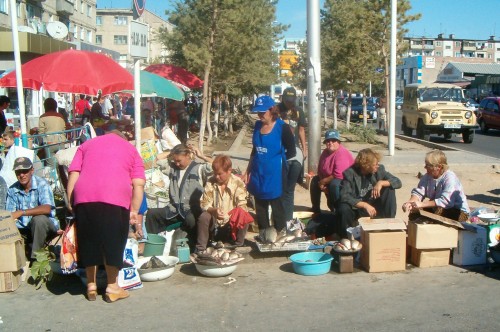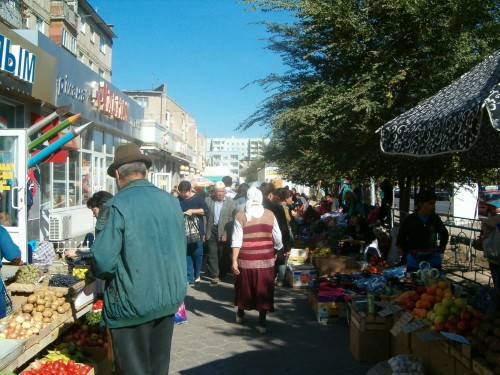I’m back with one of the many Deleted Scenes. This one is something of a hybrid — parts of it show up at a later time in the book. But here’s the original description of this amazing place, the one spot in Zhezkazgan for which I could say, “It was as close to the exotic as I’d find.”
There was a third burst of color in the otherwise neutral beige that was the town and we found it a few days later: the Sharwa bazaar.
Its outside walls were painted the same bright Easter-egg-blue I’d see so often, the same blue in Kazakhstan’s flag. I would see that color daily in exterior window frames, student desks, walls and draperies at my college.
Here it was again at the bazaar, a two-block long solid azure, windowless plywood structure, with a series of overlapping tarps for a roof. Inside, the bazaar did not close for lunch.
We entered first into a large, airy produce section, awash with glorious color from apples, oranges, beets, grapes, lemons, and even lettuce, sorrel probably, given its sour taste. Vendors selling dried apricots, raisins, and nuts called out to sample their wares.

To my left was the “bulk food” section: rows of jars filled with colorless grains and pastas. Never before had I been so aware of color, or the lack of it.
The bazaar went on for blocks, filled with clothes, pots and pans, and stationery in every conceivable configuration of display, looking remarkably similar in quality and selection. All were displayed in dark, narrow booths, their wares hanging high above our heads.
Produce and products spilled over to the outside, as well. Overflowing boxes of onions, carrots, potatoes, beets, and melons took up two thirds of the sidewalk space, leaving a pathway less than two feet wide for pedestrians going in two directions.

There were large, cut flowers I didn’t recognize in yellows, reds, and browns. The tomatoes were shiny and deep red, and I hungered to buy one and eat it like an apple, the juice running down my arms and chin. But I had no way to peel it and peel it I must. I passed on the tomatoes.
On a nearby corner, several women squatted beside a catch of fish larger than I’d ever seen, with flies buzzing around. The smell reached me ten feet away.

Were these the vendors who couldn’t get inside the bazaar? What must one do to sell inside the bazaar? Are there forms to fill out, a waiting list to get on, or bribes to pay? Are the spots passed down from one generation to the next, like season tickets at Yankee Stadium?
So many questions and, I realized gratefully, plenty of time. We’d be here for two years.
Sharwa Bazaar and its busy sidewalk vendors were book-ended by blocks of adjacent stores — food, clothing, hardware, books, furniture, kitchen utensils, wrapping paper, DVDs, CDs, and videotapes – all at Dollar Store prices.

We wandered slowly along, voyeurs watching safely through the language barrier that separated us from the crowd.
Nekrasova was a busy road, its sidewalk crowded with people: a Zhezkazgan Fifth Avenue, or maybe Orchard Street. The difference, though, was that no one seemed to be in any particular hurry.
It was as close to exotic as I’d find.
possum
Having just finished your book, it is great fun to have some pictures to go along with it – pictures to compare to what I imagined. Your Bazaar was very similar to the bazaars in rural Turkey, likewise the great burst of color after miles and miles of drab greys and browns broken only by the occasional red tile roof.
Great story… I was able to walk right along with you, smelling the smells (good and bad) and drooling over food that had to be soaked in that Clorox solution or peeled. But it was easy to be a vegetarian when walking past the meats and fish displays.
Can’t wait for more pictures of your friends and places!
Janet Givens
Hi Jan. You must have bought the Large Print version. I just learned that that bid didn’t come with pictures. I’m so sorry. But I promise to post more as the weeks go on. Loved seeing the pix of you on your recent blog.
Marian Beaman
Luscious post! Even without the photos, I can visualize the bounty you describe.
Janet Givens
Hi Marian. Thanks so much. Have to tell you, when I saw the title of your recent post, I popped over to your site thinking, now I’ll get to see what a bougainvillea looks like. This bloom has been stalking me for many months, popping up in stories neatly daily. And I have no clue to what it looks like. I only know it’s a hot weather plant. (We don’t have them in Vermont). But they sound lovely.
Yvonne Hertzberger
What a wonderful experience. It reminds me a little of the market at s’Hertogenbosch in The Netherlands.
Janet Givens
Hi Yvonne and welcome back. I’d forgotten we shared a Dutch connection. My favorite Dutch market in Holland was in Arnheim where I sampled my first RAW herring. Yum.
Kathleen Pooler
Janet, having recently finished your lovely memoir, I am delighted you are continuing to share such rich scenes. You bring us right there with you. I can almost taste and smell that luscious produce. But I’m not so sure about the fish! Thank you for sharing.
Janet Givens
Hi Kathy. Good decision! We never had the fish in the two years we were there. See you soon.